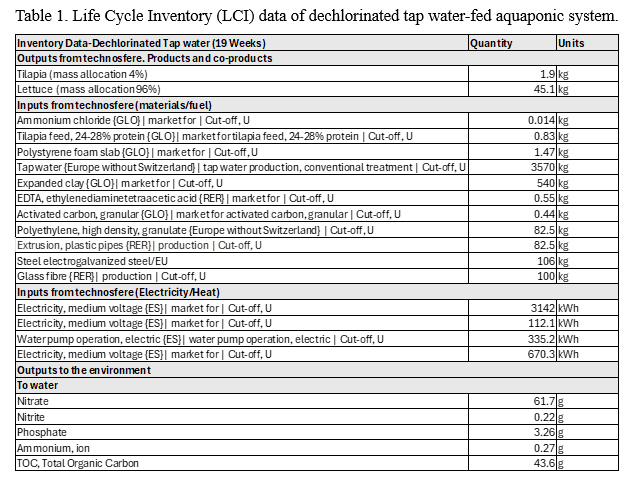LIFE CYCLE ASSESSMENT OF RECLAIMED WASTEWATER-FED AQUAPONIC FARM
Introduction
Aquaponics is an unconventional method of fish and crop production, which combines aquaculture with hydroponics. Aquaponics can be installed in rocky, saline and no -arable lands, with no requirements for fertilisers and insecticides/herbicides. This contributes to reducing soil occupation and deterioration, alleviating the pressure on water resources, and reducing agriculture impact on the environment [1] .
Urban wastewater is increasingly used for agriculture due to increasing water scarcity and stress, together with expanding populations, rising wastewater disposal levels and contamination episodes . U rban ecosystems should consider developing new markets for wastewater, diverting a higher percentage of wastewater inland, making productive use of wastewaters not only for agriculture but also for aquaculture and aquaponics [2,3] . For example, reclaimed water can reduce the geographical dependency of aquaculture to freshwater, so that it can be located anywhere near a city with wastewater treatment plants. This would result in a decrease in production costs and the procurement of fresh produce of high protein content to the benefit of local communities [4]. However, low public acceptance and lack of regulations are the main barriers [5].
The main goal of this work is to prove the reduction of environmental footprint of using reclaimed water in aquaponic farms assuring productivity and food safety within the frame of the project Aquaponics from wastewater reclamation (AWARE) GA N. 101084245 . To do this an experimental small-scale aquaponic farm has been coupled to a pilot-scale urban wastewater treatment plant at URJC, Madrid, Spain . Advanced tertiary treatment of wastewater has been tailored to feed the aquaponic farm to produce lettuce and Tilapia. E nvironmental performance of reclaimed urban wastewater-fed aquaponic farm has been evaluated.
Materials and Methods
Water advanced tertiary treatment was used to polish wastewater effluent from a wastewater treatment plant (WWTP). This process was composed of serial modules of Ultrafiltration (UF) , electrooxidation (EO) and radiation with a total of 60 UVC-LED . The UF membrane is Al2O3 , size pore of 100 nm, 0.23 m2 x 1.2 m. The anode of the EO module corresponds to Ti/MMO ( mixed metal oxides) and Ti is used as cathode, 270 cm2 , 5.2 A, 10-15 V, 78.85 J . The wavelength of UVC-LED radiation is in the range of 268-280 nm, with maximum emission of 275 nm , and energy of 102.99 J. The flow rate corresponded to 200 L/h.
In this study 1 m3 reclaimed urban wastewater-fed aquaponic system stocked with 50 Nile tilapia (Oreochromis niloticus L., stocked at 5.7 kg per system) and 72 lettuce plants (Lactuca sativa Batavian Red) for 22 lettuce cycles of 5 weeks. The experiment was conducted in a small scale, closed-loop, simple recirculating aquaculture system (RAS) running for 19 weeks. Control with dechlorinated tap water was also performed as base line.
A gate-to-gate life cycle assessment (LCA) was used following a standardised methodology by ISO 14040 and 14044. The selected functional unit (FU) was 1 kg of Tilapia. Mass allocation was applied to distribution environmental impacts and burdens across co-products. To prepare the inventory data the ecoinvent v3.8 was used, and the cut-off options for the unit process were selected. The reference method proposed by the European Commission , Environmental Footprint (EF) 3.0, was employed . T o quantify the potential environmental impacts SimaPro 9.4 was used.
Results
The main system features ( including raw materials for building and running the facility) ; consumptions (energy and water); and production (fish feed, fish, lettuce, dead biomass, sludge ) are shown in Table 1. The advanced tertiary treatment was also accounted for raw materials and energy
Conclusions
Electricity use (pumps, lights, heaters) is the main contributor to Global Warming Potential together with energy demand depending on climate, and lighting. Nutrients in effluent discharge affect eutrophication potential . Comparing aquaponics using dechlorinated tap water with one using reclaimed urban wastewater introduces key environmental trade-offs. The reclaimed water reduces freshwater demand and embodied energy, but may introduce higher treatment energy.
Literature
[1] Greenfeld, A., Becker, N., McIlwain, J., Fotedar, R., & Bornman, J. F. (2019). Economically viable aquaponics? Identifying the gap between potential and current uncertainties. Reviews in Aquaculture, 11(3), 848-862. doi:10.1111/raq.12269
[2] Urban Aquaculture. 2005. Eds. 10.1079/9780851998299.0001
[3 ] Stuart W. Bunting, Confronting the realities of wastewater aquaculture in peri-urban Kolkata with bioeconomic modelling, Water Research, Volume 41, Issue 2, 2007, 499-505.
[4] Cifuentes-Torres Liliana, Correa-Reyes Gabriel, Mendoza-Espinosa Leopoldo G. Can Reclaimed Water Be Used for Sustainable Food Production in Aquaponics ? Frontiers in Plant Science , 12 2021 , 981
[5 ] Official Journal of the European Union, 2020 “REGULATION (EU) 2020/741 OF THE EUROPEAN PARLIAMENT AND OF THE COUNCIL of 25 May 2020 on minimum requirements for water reuse”.
